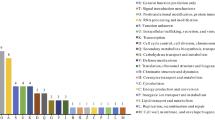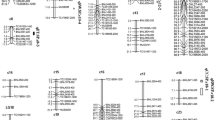Abstract
Existing cotton EST-SSR markers are mostly derived from Gossypium arboreum and Gossypium hirsutum, but EST-SSR markers from Gossypium barbadense are scarce. One hundred and nineteen EST-SSRs were developed based on 98 unique ESTs from a cDNA library constructed in our laboratory using developing fibers from G. barbadense cv. Pima3–79. Among the SSRs, trinucleotide AAG appeared at a high frequency of 11.76%. 36 accessions (consisting of 13 diploids of the A genome, 11 diploids of the D genome and 12 allotetraploids of the AD genome) were employed to test new EST-SSRs. 76 EST-SSRs were successfully amplified, and 313 polymorphic fragments were yielded, with an average of 4.11 fragments per primer pair. The PIC ranged from 0.17 to 0.95 with an average of 0.53. Based on Jaccard’s genetic similarity coefficient, these 36 accessions were clustered into three groups. 21 EST-SSRs exhibited polymorphisms in BC1 population ((Emian22 × Pima3–79) × Emian22), 24 polymorphic loci were generated, while 22 of the 24 polymorphic loci were integrated with our interspecific BC1 backbone genetic linkage map, and anchored in 12 chromosomes. This study effectively proved that EST-SSRs from G. barbadense are valuable for genetic diversity analysis and genetic mapping.
Similar content being viewed by others
References
Hof J V, Saha S. Cotton fibers can undergo cell division. Am J Bot, 1997, 84(9): 1231–1235
Kim H J, Triplett B A. Cotton fiber growth in planta and in vitro. Models for plant cell elongation and cell wall biogenesis. Plant Physiol, 2001, 127: 1361–1366
Shen X L, Guo W Z, Zhu X F. Molecular mapping of QTLs for fiber qualities in three diverse lines in Upland cotton using SSR markers. Mol Breed, 2005, 15: 169–181
Qamaruz Z F, Michael F F, Parker J S, et al. Molecular techniques employed in the assessment of genetic diversity: A review focusing on orchid conservation. Lindleyana, 1998, 13: 259–283
Powell W, Machray G C, Provan J. Polymorphism revealed by simple sequence repeats. Trends Plant Sci, 1996, 1: 215–222
Tautz D, Schotterer C. Simple sequences. Curr Opin Genet, 1994, 4: 832–837
Gupta P K, Balyan H S, Sharma P C, et al. Microsatellites in plants: a new class of molecular markers. Curr Sci, 1996, 70: 45–54
Weber J L, May P E. Abundance class of human DNA polymorphisms which can be typed using the polymerase chain reaction. Am J Hum Genet, 1989, 44: 388–396
Combes M C, Andrzejewski S, Anthony F, et al. Characterization of microsatellite loci in Coffea arabica and related coffee species. Mol Ecol, 2000, 8: 1171–1193
Saha S, Karaca M, Jenkins J N, et al. Simple sequence repeats as useful resources to study transcribed genes of cotton. Euphytica, 2003, 130: 355–364
Qureshi S N, Saha S, Kantety R V, et al. EST-SSR: A new class of genetic markers in cotton. J Cotton Sci, 2004, 8: 112–123
Chee P W, Rong J, Williams C D, et al. EST derived PCR-based markers for functional gene homologues in cotton. Genome, 2004, 47: 449–462
Han Z G, Guo W Z, Song X, et al. Genetic mapping of EST derived microsatellites from the diploid Gossypium arboreum in allotetraploid cotton. Mol Genet Genomics, 2004, 272: 308–327
Han Z G, Wang C B, Song X L, et al. Characteristics, development and mapping of Gossypium hirsutum derived EST-SSRs in allotetraploid cotton. Theor Appl Genet, 2006, 112: 430–439
Park Y H, Alabady M S, Ulloa M, et al. Genetic mapping of new cotton fiber loci using EST-derived microsatellites in an interspecific recombinant inbred (RIL) cotton population. Mol Genet Genomics, 2005, 274: 428–441
Taliercio E, Allen R D, Essenberg M, et al. Analysis of ESTs from multiple Gossypium hirsutum tissues and identification of SSRs. Genome, 2006, 49: 306–319
Paterson A H, Brubaker C, Wendel J F. A rapid method for extraction of cotton (Gossypium spp.) genomic DNA suitable for RFLP or PCR analysis. Plant Mol Biol Rep, 1993, 11: 122–127
Lin Z X, He D H, Zhang X L, et al. Linkage map construction and mapping QTLs for cotton fiber quality using SRAP, SSR and RAPD. Plant Breed, 2005, 124: 180–187
Botstein D, White R L, Skolnick M, et al. Construction of a genetic linkage map in man using restriction fragment length polymorphisms. Am J Hum Genet, 1980, 32: 314–331
Anderson J A, Churchill G A, Autrique J E, et al. Optimizing parental selection for genetic linkage maps. Genome, 1993, 36: 181–186
Rohlf F J. NTSYS-pc: Numerical Taxonomy and Multivariate Analysis System, Version 2.1, User Guide. New York: Exeter Software, 2000
Sokal R R, Michener C D. A statistical method for evaluating systematic relationships. Univ Kansas Sci Bull, 1958, 28: 1409–1438
Sneath, P H, Sokal R R. Numerical Taxonomy: The Principal and Practice of Numerical Classification. San Francisco: W. H. Freeman and Company, 1973
Lander E S, Green P, Abrahamson J, et al. MAPMAKER: An interactive computer package for constructing primary genetic linkage maps of experimental and natural populations. Genomics, 1987, 1: 174–181
Kosambi D D. The estimation of map distances from recombination values. Ann Eugen, 1994, 12: 172–175
Chin E C L. Maize simple repetitive DNA sequences: Abundance and allele variation. Genome, 1996, 156: 847–854
Temnykh S, Park W D, Ayres N, et al. Mapping and genome organization of microsatellite sequences in rice (Oryza sativa L.). Theor Appl Genet, 2000, 100: 697–712
Morgante M, Hanafey M, Powell W. Microsatellites are preferentially associated with nonrepetitive DNA in plant genomes. Nature Genet, 2002, 30: 194–200
Thiel T, Michalek W, Varshney R K, et al. Exploiting EST databases for the development and characterization of gene-derived SSR-markers in barley (Hordeum vulgare L.). Theor Appl Genet, 2003, 106: 411–422
Fryxell P A. A revised taxonomic interpretation of Gossypium L. (Makvaceae). Rheedea, 1992, 2(2): 108–165
Wang C B, Guo W Z, Cai C P, et al. Characterization, development and exploitation of EST-derived microsatellites in Gossypium raimondii Ulbrich. Chin Sci Bull, 2006, 51(5): 557–561
Gao L F, Jing R L, Huo N X, et al. One hundred and one new microsatellite loci derived from ESTs (EST-SSRs) in bread wheat. Theor Appl Genet, 2004, 108: 1392–1400
Varshney R K, Graner A, Sorrells M E. Genic microsatellite markers in plants: Features and applications. Trends Biotechnol, 2005, 23: 48–55
Frelichowski J E, Palmer M B, Main D, et al. Cotton genome mapping with new microsatellites from Acala ‘Maxxa’ BAC-ends. Mol Gen Genomics, 2006, 275: 479–491
Blair M W, Giraldo M C, Buendía H F, et al. Microsatellite marker diversity in common bean (Phaseolus vulgaris L.). Theor Appl Genet, 2006, 113: 100–109
Rong J, Bowers J E, Schulze S R, et al. Comparative genomics of Gossypium and Arabidopsis: Unraveling the consequences of both ancient and recent polyploidy. Genome Res, 2005, 15: 1198–1210
Scott K D, Eggler P, Seaton G, et al. Analysis of SSRs derived from grapes EST. Theor Appl Genet, 2000, 100: 723–726
Eujayl I, Sorrells M E, Wolters P, et al. Isolation of EST-derived microsatellite markers for genotyping the A and B genomes of wheat. Theor Appl Genet, 2002, 104: 399–407
Kantety R V, Rota M L, Matthews D E, et al. Data mining for simple sequence repeats in expressed sequence tags from barely, maize, rice, sorghum and wheat. Plant Mol Biol, 2002, 48: 501–510
Author information
Authors and Affiliations
Corresponding author
Additional information
Contributed equally to this work
Support from the Ministry of Science and Technology of China (973 Project, Grant No. 2004 CB117301) and the National Natural Science Foundation of China (Grant No. 30600396)
About this article
Cite this article
Zhang, Y., Lin, Z., Li, W. et al. Studies of new EST-SSRs derived from Gossypium barbadense . CHINESE SCI BULL 52, 2522–2531 (2007). https://doi.org/10.1007/s11434-007-0399-2
Received:
Accepted:
Issue Date:
DOI: https://doi.org/10.1007/s11434-007-0399-2




